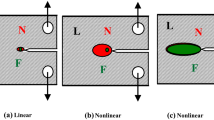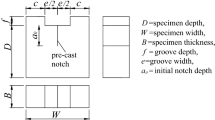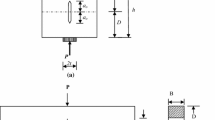Abstract
This paper shows how the double-K fracture parameters K iniIc and K unIc can be determined for concrete using CT-specimens and wedge splitting specimens. The experimental results collected from the fracture tests the very large size CT-specimens and small size wedge splitting specimens carried out by many researchers are utilized to investigate the characters of the obtained double-K fracture parameters K iniIc and K unIc . It was found that the double-K fracture parameters K iniIc and K unIc determined from fracture tests on the large size CT-specimens are size-independent. And the values of K iniIc and K unIc determined from small size wedge splitting specimens with same dimensions are independent of the relative preformed notch length a0/D. However, when the dimensions of small size wedge splitting specimens change from 150×150×150 mm3 to 450×450×450 mm3, the values of K iniIc and K unIc slightly depend on the heights of the specimens and do not depend on the thickness of the specimens.
Similar content being viewed by others
References
ASTM Standard E399–72 (1972). Standard Method of Test for Plane-Strain Fracture Toughness of Metallic Materials. Annual Book of ASTM Standards.
Brühwiler, E. and Wittmann, F.H. (1990). The wedge splitting test, a new method of performing stable fracture mechanics tests. Engineering Fracture Mechanics 35(1–3), 117–125.
CEB-Comite Euro-International du Beton-EB-FIP Model Code 1990, Bulletin D'Information, No. 213/214, Lausanne, May 1993.
Heilmann, H.G. (1969). Beziehnungen zwischen Zug-und Druckfestgkeit des Betons. Beton 19, H.2, 68–70.
Hillemeier, B. and Hilsdorf, H.K. (1977). Fracture mechanics studies on concrete compounds. Cement and Concrete Research 7(5), 523–535.
Karihaloo, B.L. and Nallathambi, P. (1991). Notched beam test: Mode I fracture toughness. Fracture Mechanics Test Methods for Concrete, Report of RILEM Technical Committee 89-FMT (Edited by S.P. Shah and A. Carpinteri), Chapman & Hall, London, 1–86.
Kim, J.K., Mihashi, H., Kirikoshi, K. and Narita, T. (1992). Fracture energy of concrete with different specimen size and strength by wedge splitting test. Fracture Mechanics of Concrete Structures (Edited by Bazant), Elsevier Applied Science, London and New York, 561–566.
Mihashi, H., Nomura, N. and Kim, J.K. (1994). Fracture mechanics properties and size effect in concrete. Size-Scale Effects in the Failure Mechanisms of Materials and Structures, E & FN Spon, 399–410.
Murakami (Editor-in-Chief) (1987). Stress Intensity Factors Handbook. Pergamon Press, London.
Ratanalert and Wecharatana, M. (1989). Evaluation of fictitious crack and two-parameter fracture models. Fracture Toughness and Fracture Energy (Edited by Mihashi et al.), Balkema, Rotterdam, 345–366.
Refai, T.M.E. and Swartz, S.E. (1987). Fracture Behavior of Concrete Beams in Three-Point Bending Considering the Influence of Size Effects. Report No. 190, Engineering Experiment Station, Kansas State University.
Reinhardt, H.W., Cornelissen, H.A.W. and Hordijk, D.A. (1986). Tensile tests and failure analysis of concrete. Journal of Structural Engineering 112(11), 2462–2477.
Wang and Wu, K. (1992). Fracture parameters of concrete as determined by means of wedge splitting test. Fracture Mechanics of Concrete Structures (Edited by Bazant), Elsevier Applied Science, London and New York, 461–464.
Wecharatana, M. and Shah, S.P. (1982). Slow crack growth in cement composites. ASCE, Journal of the Structural Division 108, 1400–1413.
Wittmann, F.H., Mihashi, H. and Nomura, N. (1990). Size effect on fracture energy of concrete. Engineering Fracture Mechanics 35(1–3), 107–115.
Xu, S. and Zhao, G. (1991). Concrete fracture toughness of huge specimens and criterion of fracture toughness for judging cracks in high concrete dam. China Civil Engineering Journal 24(2), 1–9 (in Chinese).
Xu, S. and Reinhardt, H.W. (1997a). Determination of double-K criterion for crack propagation in quasi-brittle fracture, Part I: Experimental investigation of crack propagation. International Journal of Fracture (current issue).
Xu, S. and Reinhardt, H.W. (1997b). Determination of double-K criterion for crack propagation in quasi-brittle fracture, Part II: Analytic evaluating and practical measuring methods for three-point bending notched beams. International Journal of Fracture (current issue).
Xu, S. and Reinhardt, H.W. (1998). Crack extension resistance and fracture properties of quasi-brittle softening materials like concrete based on the complete process of fracture. International Journal of Fracture 92, 71–99.
Xu, S., Zhao, G., Huang, C., Liu, Y., Jin, G. and Wang, F. (1991). Fracture energy and strain field near the tip of a notch in huge concrete specimen under compact tension. Journal of Hydraulic Engineering 11, 17–25 (in Chinese).
Zhao, G., Jiao, H. and Xu, S. (1991). Study on fracture behavior with wedge splitting test method. Fracture Processes in Concrete, Rock and Ceramics (Edited by van Mier et al.), E & F.N. Spon, London, 789–798.
Zhu, X. (1997). Transport organischer Flüssigkeiten in Betonbauteilen mit Mikro-und Biegerissen. Deutscher Ausschuss für Stahlbeton, Heft 475, Beuth Verlag GmbH, Berlin, S. 1–104.
Author information
Authors and Affiliations
Rights and permissions
About this article
Cite this article
Xu, S., Reinhardt, H.W. Determination of double-K criterion for crack propagation in quasi-brittle fracture, Part III: Compact tension specimens and wedge splitting specimens. International Journal of Fracture 98, 179–193 (1999). https://doi.org/10.1023/A:1018788611620
Issue Date:
DOI: https://doi.org/10.1023/A:1018788611620




